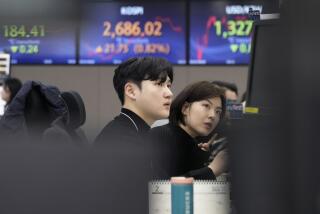Bull market in stocks reaches six years, and it may keep running

The bull market in stocks celebrated its sixth anniversary with another hike Monday, helping to offset a rough start to March — and analysts believe the bull has further to run.
The Dow Jones industrial average rose 138.94 points, or 0.8%, to 17,995.72, and the Standard & Poor’s 500 gained 8.17, or 0.4%, to 2,079.43 as signs of continued strength in the U.S. economy offset worries about slowdowns overseas. The Nadaq composite index rose 15.07, or 0.3%, to 4,942.44.
Investors reversed course from Friday’s heavy losses that came after a strong report on new jobs created last month revived fears that the Federal Reserve would act sooner rather than later to raise interest rates, which have been rock-bottom for longer than the bull market’s run.
The Dow and the S&P 500 hit lows March 9, 2009, as regulators, lawmakers and Wall Street struggled with the aftermath of the credit crisis that gripped the world about six months earlier.
The climb back has been relatively steady as the economy eventually recovered and corporate earnings began to rebound.
The S&P 500 was up about 207% through Monday, and the blue-chip Dow was up about 175%. Some analysts chalked up the difference to the fact that the Dow had not added powerhouse Apple Inc. to its index. The owner of the index said Friday that Apple would join the Dow this month.
Only three other bull markets since World War II have lasted as long, Sam Stovall, U.S. equity strategist for S&P Capital IQ, said in a research note.
“One mustn’t pooh-pooh a sixth birthday,” he wrote. “It’s a special accomplishment.”
Stovall said the longest postwar bull market began in October 1990 and lasted more than nine years, resulting in a 417% gain in the S&P, before ending in the tech wreck that started in March 2000.
The other two longer bulls were from June 1949 to August 1956, or a bit more than seven years, and from October 1974 to 1980, or six years and two months. The Reagan-era bull market lasted from August 1982 to August 1987, or a little more than five years.
A bull market is generally defined as a rising market that avoids a downturn of 20% or more. Markets, which had peaked in October 2007, already were in bear market territory when Lehman Brothers declared bankruptcy in September 2008. That started a rout in stocks, and by early March the S&P 500 had lost 57% from its peak.
Wall Street analysts at the start of the year generally predicted continued growth in U.S. stocks this year, albeit at a moderating pace. With the U.S. economy growing at fairly robust levels, the biggest macroeconomic risks were seen as slowing growth in China and the threat of a deflationary spiral in Europe.
“The market is not cheap,” said John Lonski, chief capital markets economist at Moody’s Analytics. “But by no measure is the market grossly overvalued or dangerously overvalued.”
Statistically, the odds are favorable for a seventh year of the bull, Stovall said. Although the longer postwar bull markets gained 19% in their sixth year, he said, the current bull gained only 12%, suggesting it has further to go.
Alan Whitman, a Morgan Stanley managing director, said the markets’ rise is a sign of increasing investor confidence that the U.S. recovery is sustainable. He added that the prospect of rising wages, which typically accompany job growth, would support higher share prices moving forward.
“There are not a lot of places in the world where you have that kind of growth experience,” he said.







